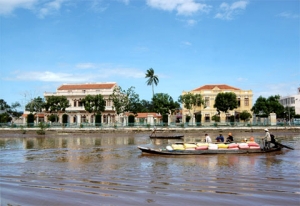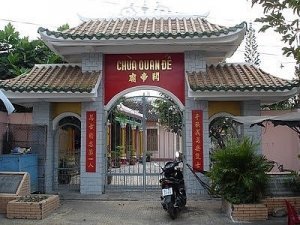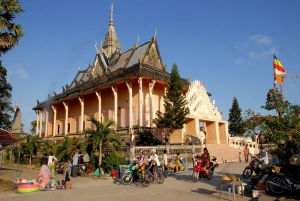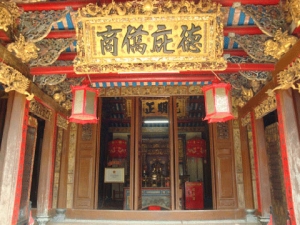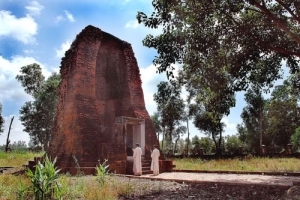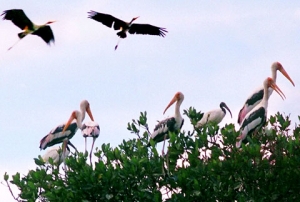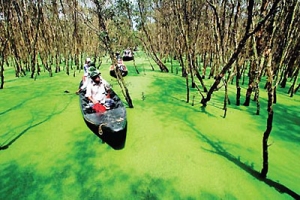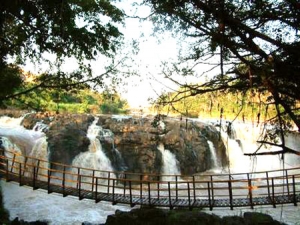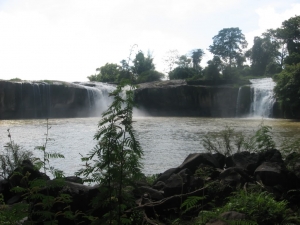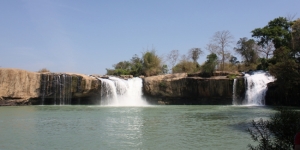
Asia Pacific Travel Team
Western Villa Complex in Bac Lieu- The Pride of Bac Lieu People
Unlike many other provinces, such as Can Tho and An Giang, there are still many western-style buildings include the villa of Bac Lieu Mandarin’s son, which stands along the river, and other buildings situated in the Hang Me Park, such as the Administration House, the court, the Bo Mansion (the building of the head mandarin) the Son quarter official building, and Dong Trach. Presently, these building are used for the provincial Library, the People’ Court of Investigation, and the office for the Bac Lieu Newspaper.
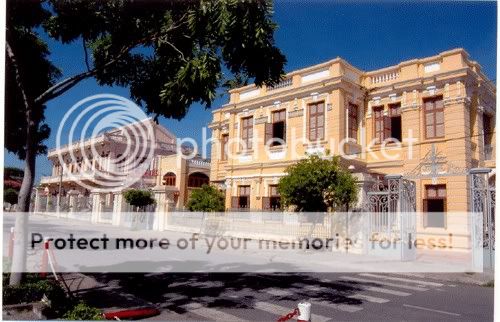
The construction materials, including steel, marble, tile, and brick, were all imported from France. The 20th century Western –style buildings have spacious surroundings, symmetrical architecture, and tile-covered roofs. The roofs are octagonal, and the supporting rafters look somewhat like those in a pagoda. The old villas and mansions of Bac Lieu have their own style, quite unlike the French villas in Hanoi, Ho Chi Minh City or Dalat.
In general, they feature high ceilings; their exteriors are washed with yellow paint, and they have high vault-like roofs.
Nowadays, the Western Villa Complex which includes the 30 mansions and villas standing along the two banks of the river in Bac Lieu has become part of the heritage of Bac Lieu Province and the pride of Bac Lieu people.
Quan De pagoda in Bac Lieu- The Symbol of Hoa People’s Culture
Quan De pagoda is situated on the bank of Bac Lieu River, Vinh Trach commune, Bac Lieu town, Bac Lieu province. The pagoda is deeply featured by the architecture of Hoa people.
Quan De pagoda is regarded as the symbol of culture by Hoa people. The pagoda was constructed in 1835 by a Chau Quai salt merchant, who encouraged local people to raise fund for its construction. The pagoda worships Quan Van Truong, a Chinese military mandarin who lived in San Kuo period. Hoa people have chosen Quan Gong, symbolizing the trust which is top priority in doing business.

Statue of Quan Gong in Quan De Pagoda
Today, the pagoda still remains several precious religious artifacts. This is a sacred place of local people and also a destination for tourists in Vietnam travel.
Xiem Can- The Largest Pagoda in Bac Lieu Province
Xiem Can Pagoda is situated 7 kilometers to the south of Bac Lieu town, on the same road that leads to the Bac Lieu Bird Sanctuary. This most beautiful pagoda is also considered the largest in the region. The pagoda was constructed in 19th century with a very special architecture style.
Tourists in Vietnam travel can see the similarities between the architecture of Xiem Can pagoda and those of Cambodia’s. That’s true! The pagoda is designed with Angkor architecture and featured by unique patterns on domes, walls, pillars, and staircases. Khmer people believe that there are challenges to Buddhists on the way to be rewarded for a devout life. That’s why there are embossment of female fairies and monsters on the pillars. They can also see images of snakes carved on domes and staircases, which proves that the Great Buddha had used his mercifulness to convert dangerous animals like snakes. Sanctum places of Khmer people often face East as they believe that the journey of being rewarded for a devout life and to be a Great Buddha is from West to East.
Khmer people highly appreciate togetherness. The pagoda is both a holy and a friendly place. The pagoda functions as a community house where they can receive help and safety. Visitors in Vietnam travel can realize the great aestheticism of the pagoda, which is expressed through the decoration patterns. On the roof of the pagoda, there is the image of Angkor Wat temple, from which the Khmer architecture originates.

Visiting the pagoda in Vietnam tourism, visitors will not only be impressed by the imposingly splendid beauty of Xiem Can pagoda, but also by the great hospitality of locals, who are truly sincere, industrious and creative. The pagoda has been constructed through generations of locals, who have worked hard to complete this sacred place.
For tourists in Vietnam travel, it is even much more exciting to visit the pagoda during the festivals such as “Ok Om Bok”, “Chol Chnam Thmay”, “Don Ta”. They special and unique cultural features of Khmer people have contributed to the diverse Vietnam culture, making the country the land of rich traditional and culture which can never be dissolve.
The Chinese Palatial Architecture Style Featured in Minh Pagoda
Minh Pagoda is located at Ward 3, Bac Lieu town, Bac Lieu province. The pagoda was established by a group of people called Minh Huong led by Tran Thiet Thuan, the headman of Vinh Huong village. The construction started from 1890 and completed in 1923.
The pagoda features the Chinese palatial architecture style of the pre-Minh dynasty. The three-door temple gates are carefully carved from stones. The two main pillars are carved with sophisticated patterns: dragons, clouds, wine gourd following the posture of dragon shrouded by mist. At the façade of the pagoda, walls are banked with many scenes of palatial ancient daily life. You can see a precisely-carved lacquered board hang at the entrance gate; this board was donated by Phuc Kien people in 1922. Besides, there are many precious items such as the copper incense and 16 types of weapons of the tutelary gods.
The central chamber worships a huge statue, featuring a man wearing his court dress. The worshipping plaque is decorated with wonderful patterns, featuring two dragons attending to the Moon, the sophisticated patterns of apricot, orchid, daisy, ivory bamboo, pine trees. On the right hand side is the worship place for Mr. Bon (Bon Dau Cong Cong). On the left hand side is the worship place for talented people who had spent their lives reclaiming the land.
Minh pagoda has great traditional and cultural value, especially for local people. For tourists in Vietnam travel, this is a sacred place where they can feel undisturbed and relaxed.
Vinh Hung Ancient Tower- Ancient Architecture Vestige
Vinh Hung tower is located in Vinh Hung A commune, Vinh Loi district, Bac Lieu province. The tower is the only ancient architecture vestige in the Mekong River Delta, originated from Angkor period of Khmer people, which is still preserved till nowadays.
Following the National highway No.1A from Bac Lieu towards Ca Mau, after driving 5 kilometers visitors in Vietnam tourism will reach Sap bridge; then turning towards the direction of Vinh Hung market, the visitors will reach Vinh Hung tower.
The tower was discovered in 1911 and at that time, it was listed as one of the historical sites in southern Vietnam. The tower is also known as Luc Hien or Bhah Dhat tower.
In the 20th century, archeologists a stele carved with Sanskrit scripts, which clearly states the 814thmonth or the 892th year (BC) in a pagoda next to the tower.
The 8,9 meter-high Vinh Hung tower is built on a hill with simple structure. In the tower, there are a Buddha’s hand made of copper; a lower body part of the Goddess; a statue of the Goddess made from green stone, statue of Goddess Brahma; a Buddha’s head made from copper and many worshipping items.

Vinh Hung Ancient Tower
Monks in the tower pagoda chant twice a day at 4:00 am and 4:00 pm. Every year, local residents organize an anniversary on the 15th day of the first lunar month at the tower. A large number of Buddhists inside and outside Bac Lieu Province pilgrimage to the pagoda to pray for good things.
If you, tourists in Vietnam travel, want good things to come to you, don’t forget to go to the pagoda and pray for them.
Bac Lieu Bird Sanctuary Nature Reserve- Attractive Eco-tourism Destination in Vietnam Tourism
Bac Lieu Province, around 100 km from the southernmost tip of Vietnam, is home to a popular bird sanctuary located in Hiep Thanh Commune of Bac Lieu Town. The sanctuary is one of the most attractive ecological tourist spots in the Mekong River Delta.
The Bac Lieu Bird Sanctuary is the vestige of a forest which ran along the East Sea coast and came into existence over a century ago. The sanctuary is just around five kilometers from the town center. It covers some 107 hectares and lies within the remaining 385 hectares of forest area. The sanctuary is now home to 46 bird species, 60 fish species, seven frog species, 10 species of mammals, eight reptile species, and 100 species of plants. On the ground are a massive number of eggs, and in the air, you can spot some species with 2 m wing-spans.
Over nearly one century, the Sanctuary is the place where generations of birds are born, usually in the rainy season, and developed. There are currently some 40,000 birds and 5,000 nests, according to preliminary statistics. Birds mostly gather here during the rainy season between May and October. In August and September, flocks of birds gather at the sanctuary to build nests and breed. The forest comes alive with the singing of various kinds of birds and trees overflow with hundreds of birds’ nests. The Sanctuary is also the important home of several water birds, mainly teal, stork, heron, night heron and cormorant.
According to documentation of Bac Lieu Bird Sanctuary Nature Reserve, in the first, it was a coastal rich and diversified salt forest floor with the natural salt-marsh ecosystem. As a part of the remaining forest floor along the East Sea, it is increasingly far from the sea due to alluvial deposits. In 1962, it was looked after, protected and controlled by a household. Then, the local authority realized that it is a precious natural property, so they have a step by step investment.

The best time for tourists in Vietnam travel to visit Bac Lieu Bird Sanctuary is in the early morning when most birds leave their nests to begin a day of feeding. Alternatively, at sunset the birds can also be seen more easily as they return to their nests to sleep, flocks of bird fly one after another. This is the moment of enjoying the most spectacular sight the sanctuary.
Moreover, the rich flora and fauna of the enclosure gives the lush, natural area a feeling of wonder and enchantment. Bac Lieu Bird Sanctuary is a favorite destination of both nature lovers and researchers and visitors in Vietnam travel will easily find several types of birds listed in Vietnam’s “Red Book” of endangered species of plants and animals. The area is also popular amongst photographers who come to the sanctuary for one-of-a-kind shots of the breathtakingly beautiful birds.
Although it has potential for further development, the Bac Lieu Bird Sanctuary remains off the radar of most large tourist companies and thus, tourists wishing to visit the area must organize travel themselves or seek out a local guide.
Traveling to Bac Lieu, tourists in Vietnam travel should not forget to visit Bac Lieu bird sanctuary nature reserve where is home to over 40 species of inhabiting bird , especially the rare and valuable ones.
Marvel at the beauty of Tra Su cajuput forest
To get to Tra Su forest, first go to Chau Doc Town in An Giang Province and take a motorbike taxi or grab a taxi and travel 17 kilometers to Tinh Bien District’s Nha Ban Town. It located in an inland area near the Cambodian border.

It includes a 845ha special-purpose forest surrounded by a 645ha buffer zone. The forest has 106 colonies of water birds, bats and various rare and endangered animals and reptiles and a few of them have been listed in the Red Book, and over 140 flora species. Standing on a 10m high watch tower in the midst of the forest, tourists in Vietnam travel can enjoy a panorama of the vast greenery spotted with the white of storks below. Turtles, snakes, as well as other reptiles and freshwater fishes are also abundant in the canals. The colour of the waterways changed from one place to another, sometimes turquoise and at other times silver, purple or amber, due to the numerous species of water creatures.

Rowing along the green mysterious canals is a particularly good ideal. Tourists in Vietnam travel can view the lovely landscape as the scenery drifts along both river banks, enjoy the fresh air as well as listen to the magical music as performed by the birds of the forest and other jungle insects and animals. The tourists will also see the wonderful countryside and farmers busily attending to their paddies, orchards and so on, but still happy to stop for a chat with guests.

During the high water season, the forest's canals and streams are dense with clusters of water ferns, a particularly vivid sight when the setting sun imparts a golden glow on the emerald-green duckweed that blankets the water's surface. Tourists in Vietnam travel can smell the perfume of lotus flowers and water lilies...
 Sunset in Tra Su forest
Sunset in Tra Su forest
Beside the significance of preservation and economic value, Tra Su also boasts many unique cultural features as it is the home of the Kh'mer and Kinh people who practice several traditional handicrafts, such as brocade weaving, silk weaving, cooking Thot not (Borassus flabellifer) sugar, distilling cajuput essential oil, raising bees for honey, etc.
Making tours in Vietnam and witness a serene but lively scene in Tra Su cajuput forest,tourists in Vietnam trave will have an unforgettable trip.
The natural beauty of Dak Nong province
Gia Nghia Town, the capital of Dak Nong Province which is 230km from Ho Chi Minh city. Covered by green hills the town has fresh, cool weather all year round. Nearly, they will see the romantic beauty of the Co Tien and Lieng Nung Waterfalls and learn about the brocade-weaving craft of the ethnic people.
The way to Dray Sap Waterfall winds through primeval forests which are thousands of years old with a large canopy of leaves. Seen from afar, the waterfall looks like a wall of water looming in a dim space and the sound of falling water can be heard from a distance. This beautiful landscape is formed by the Krong No and Krong A Na Rivers which are called Husband and Wife Rivers by the Ede and M’Nong ethnic people.
Nearly, the Dray Sap Waterfall is Gia Long Waterfall with the murmuring sound of falling water. It lies in a quiet place. The waterfall was named after King Gia Long of the Nguyen Dynasty (19th century) who once came to this place to rest and enjoy the scenery.
 Gia Long Waterfall
Gia Long Waterfall
Aside from a system of waterfalls, Dak Nong has many natural lakes in the mountains and forests, which together with such natural reserves as the Nam Nung and Ta Dung have created attractive eco-tourist routes. Ea Sno Lake covering over 80ha is an amazing natural landscape associated with the folk legends and customs of the local people. Visitors can take a boat ride to enjoy the beauty of green hills, or go downstream to the Dray Sap Waterfall or upstream to visit Choah and Bu Nor Hamlets, the native places of chiefs Guh Trang and No Trang Long who led the M’Nong ethnic people against the French invaders to protect their land.
Dak Nong Province is known as the homeland of epics, gongs and legendary stories. It is located in the Space of Gong Culture in the Central Highlands which has been recognized by UNESCO as Masterpieces of the Oral and Intangible Heritage of Humanity.
During the festival season in Dak Nong, visitors will have a change to drink Can wine with the villagers, enjoy gong performances near a flickering camp-fire, listen to epic songs sung by elderly villagers and enjoy the delicious specialties of the mountainous area.

Drinking Can wine in festival
The natural resources and culture of Dak Nong area are like rough gems which are being polished and used. Hopefully, in the near future, the “pearl” of Dak Nong will make the Central Highland, more beautiful and affluent.
The sparkling beauty of Trinh Nu Waterfall
Trinh Nu also called as Dray Nur waterfall is located in Dray Sap commune, Krong Ana district, Dak Lak province. Its name means “female waterfall”. So, it has also another informal name which is Vo waterfall (Wife waterfall). The waterfall has another part of lower Dray Nur, which is located in Dak Nong province.
According to the legend there is a sad story about a virgin girl who had toughness in her love and she came here for the suicide. Trinh Nu is right next to Dray Sap waterfall in Dak Nong province. There is only one String Bridge to come to Dray Sap. Here, those are the two beautiful and grandiose waterfalls.
Especially, behind the water screen of this waterfall, there is a big grotto. People could go inside the screen without getting wet.
In the rainy season, when water strongly flows on the river, from far tourists in Vietnam travel can hear the sound of water slapping to the rock, resounding all over the forest. This attracts visitors to come to the spring coast to contemplate the majestic, natural landscape of the waterfall.
In the waterfall, there are hundreds of stones with various shapes, locating all over the spring. Of those which, many white stones which are pockmarked like corals, and colorful stones lying alternatively which are brilliant like marbles in the fish lake. Moreover, the flow is also special because it doesn’t flood from the high but still makes up far-resounding sound like flowing from the several-meter height, spreading white foam.

If you don't want to go on, you can stop in cute thatched tents, seeing the immense rock field in the upstream or the large green forest in the downstream and enjoying the good-smelling grilled meat, hot tube wine under the light sunshine, dry wind of this area.
Gialong Waterfall- a majestic and wild beauty
Gia Long or Dray Sap Thuong (Upper Dray Sap) waterfall, located in Dak Sor commune, Krong No district, Dak Nong province, is the upper reaches of the system of three waterfalls: Gia Long, Dray Nur and Dray Sap in Serepok River.
The locals living here long after called Gia Long waterfall that is derived from King Gia Long had ever come to rest and the mountains to cut a path to a charming waterfall. which is a pool where the kings of relaxation.
The water in the waterfall runs very fast and the water curls flows from the height of about 50m with the 100m width of Serepok, which overflows the waterfall area to make it look like the boiling oil pan flowing to the lower section.
Tourists in Vietnam travel will be very impressed by the wonderful beauty o The Waterfall and the space of jungle nearby, which embraces the Tam Tien lake (Naked Bathing Lake). This is the natural creation covering the width of 80 sq m. Moreover, though located in the rapid scheme of Seropok, it still has the pure water line from the inside of the mountain. The natural scenery in this complex contains all the typical features: singing sounds of birds, special utilizing of ecology with precious wood trees and fully done tourism infrastructure, etc. Therefore, the landscape has attracted many tourists to come and rest here.

The road leads to Gialong Waterfall

The jungle near Gialong Waterfall

Gialong Waterfall


